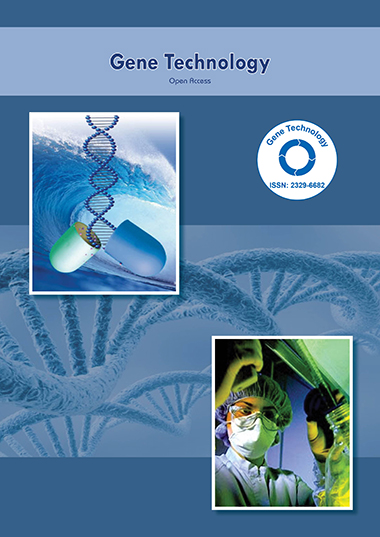Indexed In
- Academic Keys
- ResearchBible
- CiteFactor
- Access to Global Online Research in Agriculture (AGORA)
- RefSeek
- Hamdard University
- EBSCO A-Z
- OCLC- WorldCat
- Publons
- Euro Pub
- Google Scholar
Useful Links
Share This Page
Journal Flyer

Open Access Journals
- Agri and Aquaculture
- Biochemistry
- Bioinformatics & Systems Biology
- Business & Management
- Chemistry
- Clinical Sciences
- Engineering
- Food & Nutrition
- General Science
- Genetics & Molecular Biology
- Immunology & Microbiology
- Medical Sciences
- Neuroscience & Psychology
- Nursing & Health Care
- Pharmaceutical Sciences
Editorial - (2021) Volume 10, Issue 1
Recent advances of Gene Therapy
Aditya Christopher*Received: 02-Feb-2021 Published: 26-Feb-2021, DOI: 10.35248/2329-6682.21.10.e117
Introduction
Quality treatment replaces a defective quality or adds another quality trying to fix illness or improve your body's capacity to battle sickness. Quality treatment holds guarantee for treating a wide scope of sicknesses, like malignant growth, cystic fibrosis, coronary illness, diabetes, hemophilia and AIDS.
Gene Therapy and its Importance
Gene therapy is an experimental technique that uses genes to treat or prevent disease. In the future, this technique may allow doctors to treat a disorder by inserting a gene into a patient’s cells instead of using drugs or surgery. Researchers are testing several approaches to gene therapy, including:
•Replacing a mutated gene that causes disease with a healthy copy of the gene.
•Inactivating, or “knocking out,” a mutated gene that is functioning improperly.
• Introducing a new gene into the body to help fight a disease.
Although gene therapy is a promising treatment option for a number of diseases (including inherited disorders, some types of cancer, and certain viral infections), the technique remains risky and is still under study to make sure that it will be safe and effective. Gene therapy is currently being tested only for diseases that have no other cures.
Example
For example, suppose a brain tumor is forming by rapidly dividing cancer cells. The reason this tumor is forming is due to some defective or mutated gene. The therapy chosen for this case would be to use a herpes virus that has had its virulence removed, rendering it harmless.
Types of Gene Therapy
There are two different types
Somatic Gene Therapy
Somatic cell gene therapy involves the placement of a human gene into a living person's somatic cells—cells that do not produce the eggs and sperm that in turn produce the next generation. Somatic cell gene therapy would aim to cure a disease only in the patient, not in the patient's descendants. It was initially conceived as introducing a properly functioning copy of a gene into a person who had a genetic disease as a result of inheriting only improperly functioning copies. Different types of somatic cell gene therapy have since been investigated for the treatment of diseases that are not primarily caused by inherited genes, such as AIDS and cancer.
The genetic aspects of somatic cell gene therapy have been largely uncontroversial. In essence, the gene therapy is merely another drug delivery system, a different way to get a normal human protein to the right place in the body. Somatic cell gene therapy therefore stands in the same position as most experimental therapies. Like such therapies, it has prompted concerns that desperate patients are not truly giving informed consent and that the possible benefits of the treatment are exaggerated.
Germ Line Gene Therapy
Germ line gene therapy is much more controversial (Nelson 2000). It would introduce ‘normal’ human genes into the eggs or sperm of parents, or into the fertilized egg or early embryo of the offspring. The goal would be to change the eventual child's genetic inheritance. This could be done in order to avoid a genetic disease or in order to introduce an ‘enhancing’ genetic variation. There have been no trials of human germ line gene therapy; indeed, there is an informal moratorium in the scientific community on trying such experiments in humans.
New genes have been successfully introduced into the germ lines of other mammals, but with very low efficiency. At the same time, pre- implantation genetic diagnosis allows parents to choose embryos based on their genetic variations, as long as the parents themselves produced the desired variations.
If not, donated eggs or sperm would be a much safer and easier way to introduce the desired genes than somatic cell gene therapy. Germ line gene therapy may turn out to be most important as a barrier to somatic cell gene therapy. If germ line gene therapy were banned, researchers using somatic gene therapy might need to make the difficult showing that the transplanted genes could not ‘infect’ the patient's germ cells and thus constitute inadvertent germ line gene therapy.
Advantages of Gene Therapy
• It offers the possibility of a positive medical outcome.
• We can treat disease or illness in meaningful ways.
•It could improve a person’s life in other ways.
•We already know that it can be a successful treatment option.
•There are out-of-body treatment options available.
•The medical impact of gene therapy can create permanent results.
•New treatment options are coming out all of the time.
•It can work in combination with cell therapy techniques.
Disadvantages of Gene Therapy
•There could be unwanted immune system reactions
•Current gene therapy methods can sometimes target the wrong cells.
•The delivery viruses might recover their ability to create disease.
•Gene therapies could cause a potential tumor.
•There is no guarantee that the gene therapy will work.
Citation: Christopher A (2021) Recent advances of Gene Therapy. Gene Technol. 10: e117.
Copyright: © 2021 Christopher. A. This is an open-access article distributed under the terms of the Creative Commons Attribution License, which permits unrestricted use, distribution, and reproduction in any medium, provided the original author and source are credited

